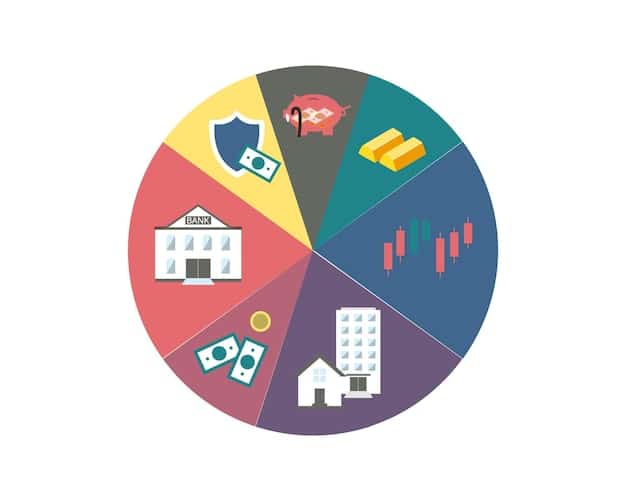How to Build a Diversified Investment Portfolio for Long-Term Growth

Building a diversified investment portfolio for long-term growth involves strategically allocating assets across various investment types to mitigate risk and maximize potential returns over an extended period.
Are you ready to secure your financial future? Learning how to build a diversified investment portfolio for long-term growth is a crucial step towards achieving your financial goals.
Understanding the Importance of Diversification
Diversification is a cornerstone of successful long-term investing. It’s about spreading your investments across different asset classes and sectors to reduce risk.
By diversifying, you’re not putting all your eggs in one basket. This means that if one investment performs poorly, it won’t significantly impact your entire portfolio.
What is Asset Allocation?
Asset allocation is the process of dividing your investment portfolio among different asset classes, such as stocks, bonds, and real estate. This decision is based on your risk tolerance, investment goals, and time horizon.
A well-thought-out asset allocation strategy can help you achieve your desired returns while minimizing risk.

Benefits of Diversification
- Mitigates Risk: Diversification helps reduce the impact of any single investment on your portfolio.
- Enhances Returns: By investing in various asset classes, you can capture different market opportunities and potentially enhance your returns.
- Provides Stability: A diversified portfolio tends to be more stable during economic downturns.
In conclusion, understanding the importance of diversification and implementing a sound asset allocation strategy are essential for building a resilient and profitable investment portfolio.
Assessing Your Risk Tolerance and Investment Goals
Before diving into specific investments, it’s crucial to understand your risk tolerance and define your investment goals. These factors will guide your investment decisions.
Risk tolerance refers to your ability and willingness to withstand potential losses in your investments. Investment goals are the financial objectives you want to achieve, such as retirement, buying a home, or funding your children’s education.
Determining Your Risk Tolerance
Consider how you would react to a significant market downturn. Are you comfortable with the possibility of losing a portion of your investment? Or would you prefer a more conservative approach with lower potential returns?
Your risk tolerance can be classified as conservative, moderate, or aggressive. Conservative investors prioritize capital preservation, while aggressive investors seek higher returns and are willing to take on more risk.
Defining Your Investment Goals
Clearly define what you want to achieve with your investments. Are you saving for retirement, a down payment on a house, or your children’s college education?
Your investment goals should be specific, measurable, achievable, relevant, and time-bound (SMART). For example, “Save $500,000 for retirement in 30 years” is a SMART goal.
In summary, by assessing your risk tolerance and clearly defining your investment goals, you can create a personalized investment strategy that aligns with your needs and aspirations.
Key Asset Classes for a Diversified Portfolio
A diversified investment portfolio typically includes a mix of asset classes, each with its own risk and return characteristics. Understanding these asset classes is essential for making informed investment decisions.
The main asset classes are stocks, bonds, real estate, and cash. Each plays a unique role in a diversified portfolio.
Stocks
Stocks represent ownership in a company and offer the potential for high returns. However, they also come with higher risk.
Investing in a variety of stocks across different sectors can help diversify your stock holdings.
Bonds
Bonds are debt securities issued by governments or corporations. They are generally considered less risky than stocks and provide a steady stream of income.
Bonds can help stabilize your portfolio during market volatility.

Real Estate
Real estate can provide diversification and potential income through rental properties. It can also appreciate in value over time.
Investing through Real Estate Investment Trusts (REITs) can provide exposure to real estate without directly owning property.
Cash
Cash includes savings accounts, money market funds, and short-term certificates of deposit (CDs). It provides liquidity and safety but offers lower returns.
Having some cash in your portfolio can help you take advantage of investment opportunities during market downturns.
In conclusion, a mix of stocks, bonds, real estate, and cash can create a well-rounded and diversified investment portfolio that balances risk and return.
Strategies for Diversifying Your Portfolio
Diversifying your investment portfolio requires a strategic approach. Here are some effective strategies to consider.
These strategies will help you spread your investments across different asset classes, sectors, and geographic regions.
Invest in Index Funds and ETFs
Index funds and Exchange-Traded Funds (ETFs) provide instant diversification by tracking a specific market index, such as the S&P 500.
These funds offer a cost-effective way to gain exposure to a broad range of stocks or bonds.
Diversify Across Sectors
Don’t concentrate your investments in one sector. Spread your investments across different sectors, such as technology, healthcare, consumer goods, and energy.
This can help reduce the impact of sector-specific risks on your portfolio.
Diversify Geographically
Invest in international stocks and bonds to diversify your portfolio beyond your home country.
This can help you capture growth opportunities in emerging markets and reduce the impact of domestic economic conditions on your investment returns.
By implementing these strategies, you can create a well-diversified portfolio that is positioned for long-term growth and resilience.
Rebalancing Your Portfolio
Rebalancing your portfolio is an essential part of maintaining your desired asset allocation and risk profile over time. Market fluctuations can cause your portfolio to drift away from your target allocation.
Rebalancing involves selling some assets that have increased in value and buying assets that have decreased in value to bring your portfolio back to its original allocation.
When to Rebalance
You can rebalance your portfolio on a regular schedule, such as annually or semi-annually. Alternatively, you can rebalance when your asset allocation deviates significantly from your target allocation, such as by 5% or 10%.
Choose a rebalancing strategy that works best for you and stick to it consistently.
Benefits of Rebalancing
Rebalancing helps you maintain your desired risk level and stay on track towards your investment goals.
It can also help you avoid overexposure to certain asset classes and take advantage of buying opportunities during market downturns.
In summary, rebalancing is a critical component of long-term investment success, helping you stay disciplined and aligned with your financial objectives.
Common Mistakes to Avoid
Building a diversified investment portfolio requires careful planning and execution. Here are some common mistakes to avoid.
Avoiding these mistakes can help you achieve better investment outcomes and protect your financial future.
Lack of Diversification
Putting all your eggs in one basket is a recipe for disaster. Make sure to diversify your investments across different asset classes, sectors, and geographic regions.
This will help reduce the impact of any single investment on your portfolio.
Emotional Investing
Making investment decisions based on fear or greed can lead to poor outcomes. Stick to your investment plan and avoid making impulsive decisions during market volatility.
Remember that investing is a long-term game, and short-term market fluctuations are normal.
Ignoring Fees
High investment fees can eat into your returns over time. Choose low-cost investment options, such as index funds and ETFs, to minimize fees.
Pay attention to expense ratios, transaction costs, and advisory fees.
By avoiding these common mistakes, you can increase your chances of building a successful and diversified investment portfolio for long-term growth.
| Key Point | Brief Description |
|---|---|
| 🎯 Asset Allocation | Strategically divide investments among stocks, bonds, and other assets. |
| ⚖️ Risk Tolerance | Understand your comfort level with potential investment losses. |
| 🔄 Rebalancing | Adjust your portfolio periodically to maintain the desired asset mix. |
| 🌎 Global Diversification | Include international investments to reduce country-specific risks. |
Frequently Asked Questions
▼
Diversification involves spreading investments across various asset classes to reduce risk. It’s important because it protects your portfolio from significant losses if one investment performs poorly, enhancing long-term stability.
▼
Rebalance your portfolio annually or semi-annually, or when your asset allocation deviates significantly (e.g., by 5-10%) from your target. This ensures your risk level remains aligned with your goals.
▼
The main asset classes are stocks, bonds, real estate, and cash. Stocks offer growth potential, bonds provide stability, real estate can generate income, and cash ensures liquidity and safety.
▼
Risk tolerance is your comfort level with potential investment losses. Determine yours by considering your financial goals, time horizon, and how you’d react to market downturns. Classify yourself as conservative, moderate, or aggressive.
▼
Invest in low-cost index funds or ETFs that offer broad market exposure. These provide instant diversification across various sectors and asset classes, even with a small investment amount, making it accessible.
Conclusion
Building a diversified investment portfolio is a journey that requires understanding, planning, and discipline. By assessing your risk tolerance, setting clear investment goals, diversifying across asset classes, and rebalancing your portfolio regularly, you can position yourself for long-term financial success. Remember to stay informed, avoid emotional investing, and seek professional advice when needed.





